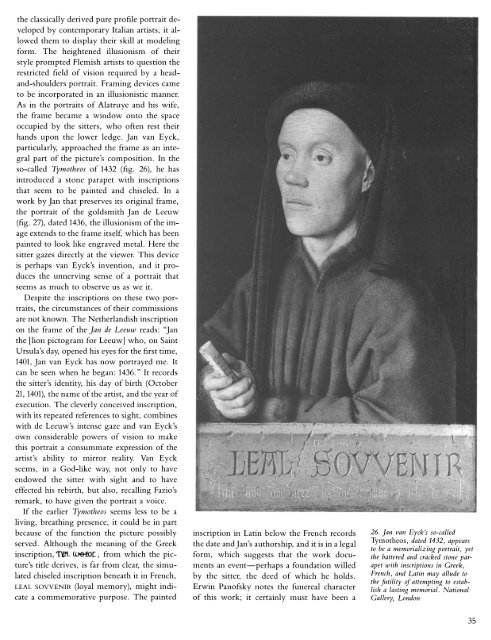Early Flemish Portraits 1425-1525: The Metropolitan Museum of Art ...
Early Flemish Portraits 1425-1525: The Metropolitan Museum of Art ...
Early Flemish Portraits 1425-1525: The Metropolitan Museum of Art ...
Create successful ePaper yourself
Turn your PDF publications into a flip-book with our unique Google optimized e-Paper software.
the classically derived pure pr<strong>of</strong>ile portrait developed<br />
by contemporary Italian artists, it allowed<br />
them to display their skill at modeling<br />
form. <strong>The</strong> heightened illusionism <strong>of</strong> their<br />
style prompted <strong>Flemish</strong> artists to question the<br />
restricted field <strong>of</strong> vision required by a headand-shoulders<br />
portrait. Framing devices came<br />
to be incorporated in an illusionistic manner.<br />
As in the portraits <strong>of</strong> Alatruye and his wife,<br />
the frame became a window onto the space<br />
occupied by the sitters, who <strong>of</strong>ten rest their<br />
hands upon the lower ledge. Jan van Eyck,<br />
particularly, approached the frame as an integral<br />
part <strong>of</strong> the picture's composition. In the<br />
so-called Tymotheos <strong>of</strong> 1432 (fig. 26), he has<br />
introduced a stone parapet with inscriptions<br />
that seem to be painted and chiseled. In a<br />
work by Jan that preserves its original frame,<br />
the portrait <strong>of</strong> the goldsmith Jan de Leeuw<br />
(fig. 27), dated 1436, the illusionism <strong>of</strong> the image<br />
extends to the frame itself, which has been<br />
painted to look like engraved metal. Here the<br />
sitter gazes directly at the viewer. This device<br />
is perhaps van Eyck's invention, and it produces<br />
the unnerving sense <strong>of</strong> a portrait that<br />
seems as much to observe us as we it.<br />
Despite the inscriptions on these two portraits,<br />
the circumstances <strong>of</strong> their commissions<br />
are not known. <strong>The</strong> Netherlandish inscription<br />
on the frame <strong>of</strong> the Jan de Leeuw reads: "Jan<br />
the [lion pictogram for Leeuw] who, on Saint<br />
Ursula's day, opened his eyes for the first time,<br />
1401, Jan van Eyck has now portrayed me. It<br />
can be seen when he began: 1436." It records<br />
the sitter's identity, his day <strong>of</strong> birth (October<br />
21, 1401), the name <strong>of</strong> the artist, and the year <strong>of</strong><br />
execution. <strong>The</strong> cleverly conceived inscription,<br />
with its repeated references to sight, combines<br />
with de Leeuw's intense gaze and van Eyck's<br />
own considerable powers <strong>of</strong> vision to make<br />
this portrait a consummate expression <strong>of</strong> the<br />
artist's ability to mirror reality. Van Eyck<br />
seems, in a God-like way, not only to have<br />
endowed the sitter with sight and to have<br />
effected his rebirth, but also, recalling Fazio's<br />
remark, to have given the portrait a voice.<br />
If the earlier Tymotheos seems less to be a<br />
living, breathing presence, it could be in part<br />
because <strong>of</strong> the function the picture possibly<br />
served. Although the meaning <strong>of</strong> the Greek<br />
inscription, TYM. 0WEOC, from which the picture's<br />
title derives, is far from clear, the simulated<br />
chiseled inscription beneath it in French,<br />
LEAL SOVVENIR (loyal memory), might indicate<br />
a commemorative purpose. <strong>The</strong> painted<br />
inscription in Latin below the French records<br />
the date andJan's authorship, and it is in a legal<br />
form, which suggests that the work documents<br />
an event-perhaps a foundation willed<br />
by the sitter, the deed <strong>of</strong> which he holds.<br />
Erwin Pan<strong>of</strong>sky notes the funereal character<br />
<strong>of</strong> this work; it certainly must have been a<br />
26. Jan van Eyck's so-called<br />
Tymotheos, dated 1432, appears<br />
to be a memorializing portrait, yet<br />
the battered and cracked stone parapet<br />
with inscriptions in Greek,<br />
French, and Latin may allude to<br />
the futility <strong>of</strong> attempting to establish<br />
a lasting memorial. National<br />
Gallery, London<br />
35

















